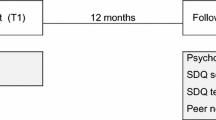Abstract
This study aims to exploring the importance of peer groups, how belonging to different types of groups affects the actual perception of oneself, the peer group and other groups, and the perception of difficulty in coping with developmental tasks. 600 adolescents from Bologna, Italy filled out a questionnaire, consisting of three parts. The results show that peer groups are important in adolescence lifes. Overall, 90% of the subjects were members of a peer group; most often they belonged to informal or quasi-informal groups.
A smaller percentage belonged to formal groups, like to sport or religious groups. The scopes to meet the groups were most often for amusement and also for talking about one’s personal problems.
Surprisingly, the differences of descriptions of oneself and the own group, oneself and the self-defined outgroup, oneself and drug abusers, did not differ considerably among informal and formal groups. Also informal and formal groups described the ingroups equally favorably and outgroups equally unfavorably. Moreover the results show that informal and formal groups did not differ in the perception of difficulty in coping with developmental tasks.
These results indicate that the type of groups is not a crucial variable in explaining differences in evolution of the self-system in adolescents.
Résumé
Le but de cette étude est d’explorer l’importance du groupe des pairs à l’adolescence et d’examiner comment l’appartenance à différents types de groupes affecte la perception actuelle de soi, de son propre groupe et des autres groupes, ainsi que la perception de la difficulté à accompli les taches de développement. 600 adolescents de Bologne (Italie) ont rempli un questionnaire divisé en trois parties.
Les résultats confirment l’importance des groupes de pairs dans la vie des adolescents. 90% des adolescents étaient membres d’un groupe de pairs, ils appartenaient le plus souvent à des groupes informels ou quasi-informels. Un plus petit pourcentage d’adolescents appartenaient à des groupes formels, par exemple des groupes sportifs ou religieux. Le plus souvent la rencontre en groupe avait pour but l’amusement et la discussion de problèmes personnels. Les groupes formels dédiaient aussi une bonne partie de leur temps à des activités organisées.
De manière surprenante, les différences entre soi-même et son propre groupe, entre soi-même et le groupe défini comme hors-groupe, entre soi-même et des consommateurs de drogue étaient pratiquement du même ordre dans les groupes informels et dans les groupes formels. Les groupes informels ont, dans la même mesure, décrit favorablement leur propre groupe et défavorablement l’hors-groupe. En outre, les résultats montrent que les groupes formels et informels ne différaient pas dans leur perception de la difficulté à accomplir les taches de développement.
Ces résultats indiquent que le type de groupe d’appartenance ne constitue pas une variable déterminante dans l’explication des différences dans l’évolution de la conception de soi à l’adolescence.
Similar content being viewed by others
References
Amerio, P., Palmonari, A., & Pombeni, M. L. (1986).I gruppi di adolescenti come fattore di socializzazione. Roma: Ministero dell’Interno.
Coleman, J. C. (1980).The nature of adolescence. London: Methuen.
Doise, W. (1978).Groups and individuals: Explanation in social psychology. Cambridge: C.U.P.
Havighurst, R. I. (1952).Developmental tasks and education. New York: David Mckay Company.
Palmonari, A., Carugati, F., Ricci, P., & Sarchielli, G. (1984). Imperfect identities: a socio-psychological perspective for the study of the problems of adolescence. In H. Tajfel (Ed.),The social dimension (pp. 111–133). Cambridge: C.U.P.
Sherif, C. W. (1984). Coordinating the sociological and psychological in adolescents interaction. In W. Doise & A. Palmonari (Eds.),Social interaction in individual development. Cambridge: C.U.P.
Sherif, M., & Sherif, C. W. (1953).Groups in harmony and tension. New York: Harper.
Sherif, M., & Sherif, C. W. (1964).Reference groups: exploration into conformity and deviation of adolescents. New York: Harper.
Sherif, M., & Sherif, C. W. (1965).Problems of youth: transition and adulthood in a changing world. Chicago: Aldine.
Silbereisen, R. K., Eyferth, K., & Rudinger, G. (1986).Development as action in context. New York, Heidelberg: Springer.
Tajfel, H. (1978).Differentiation between social groups: Studies in the social psychology of intergroup relations. London: Academic Press.
Tajfel, H. (1981).Human groups and social categories. Cambridge: University Press.
Tajfel, H. (1982).Social identity and intergroup relations. Cambridge: C.U.P.
Author information
Authors and Affiliations
Additional information
The research reported in this paper was supported by research grants C.N.R. 820226156 and 830276456.
Rights and permissions
About this article
Cite this article
Palmonari, A., Pombeni, M.L. & Kirchler, E. Peergroups and evolution of the self-system in adolescence. Eur J Psychol Educ 4, 3–15 (1989). https://doi.org/10.1007/BF03172757
Issue Date:
DOI: https://doi.org/10.1007/BF03172757




